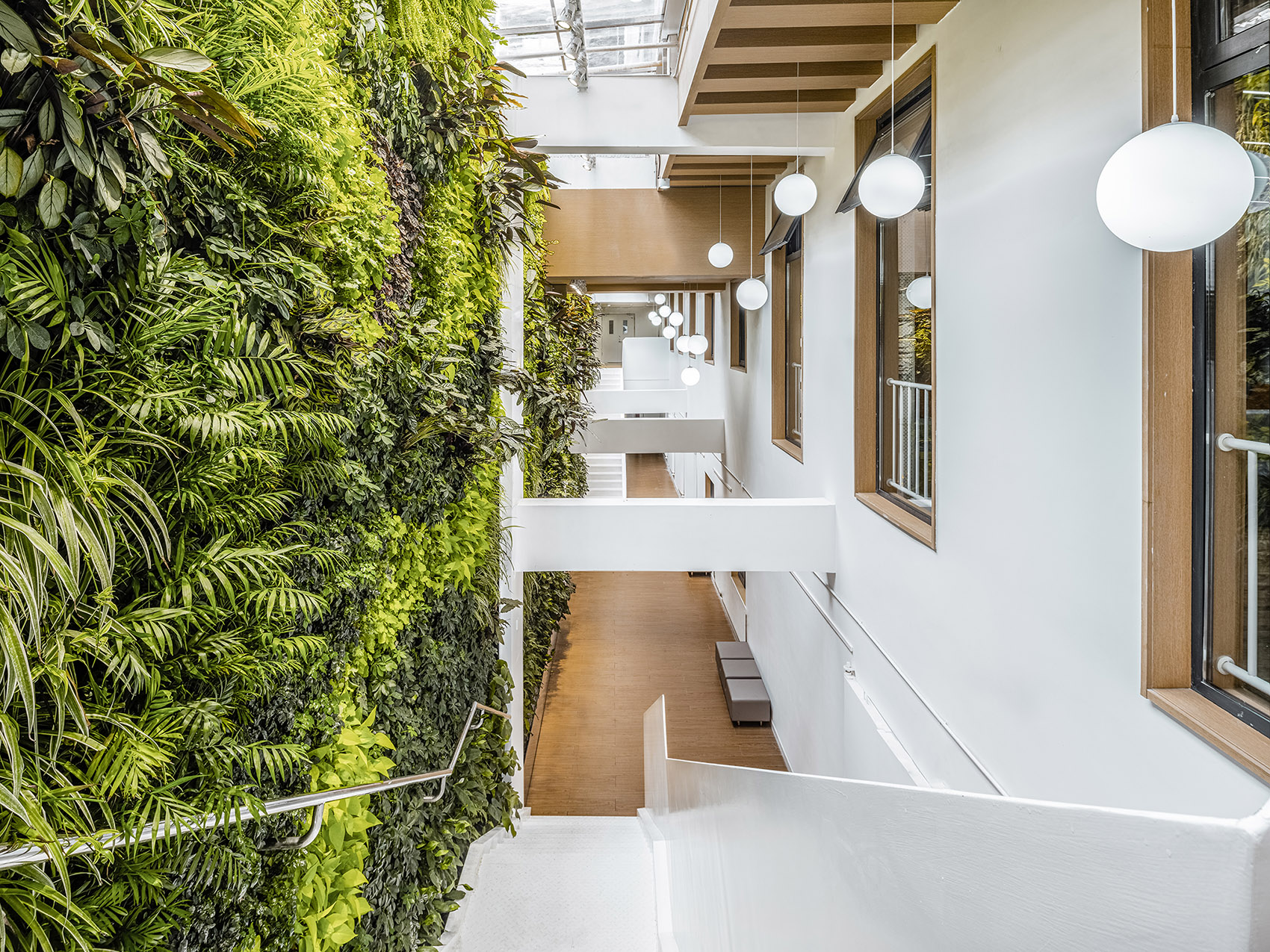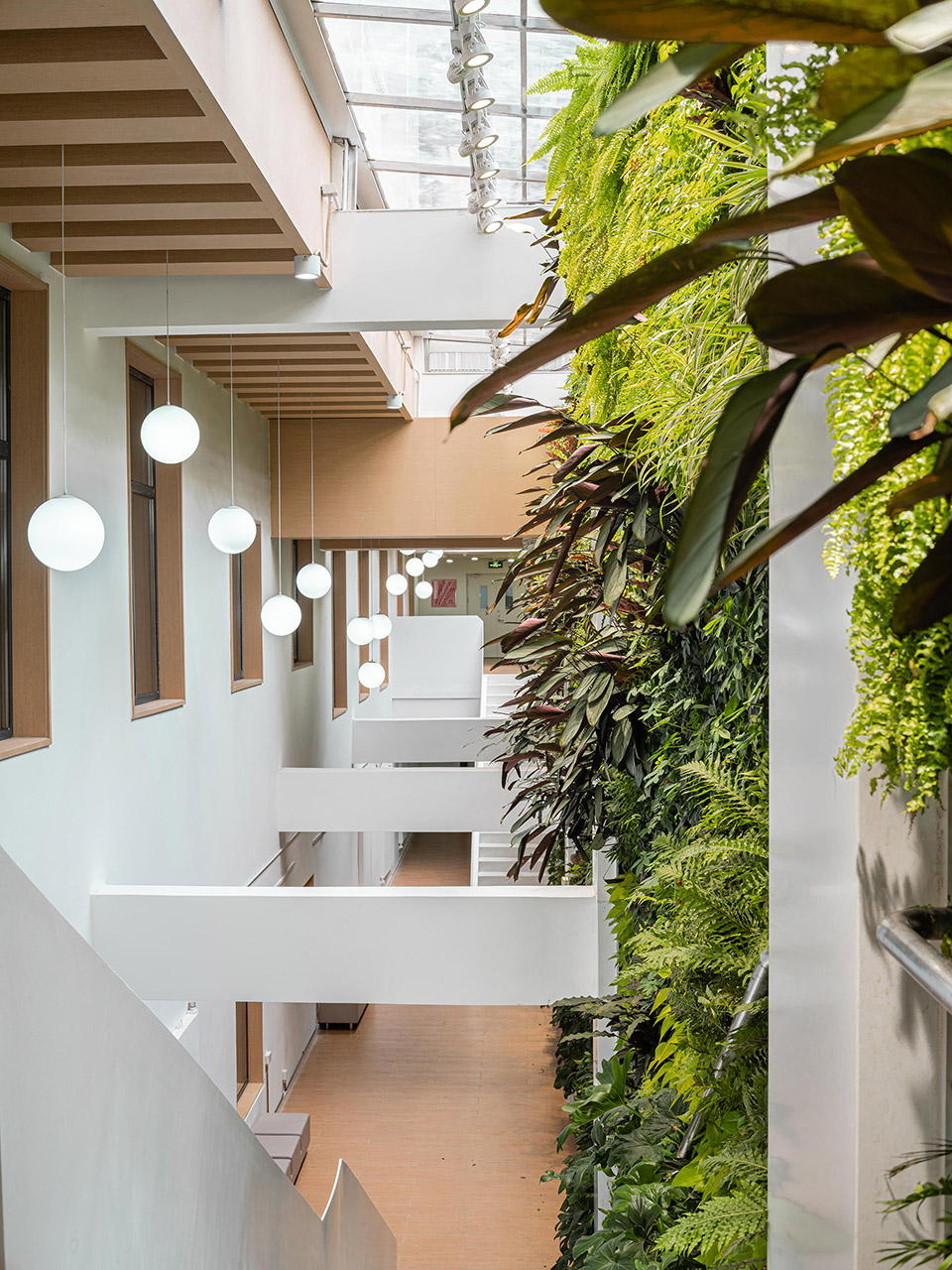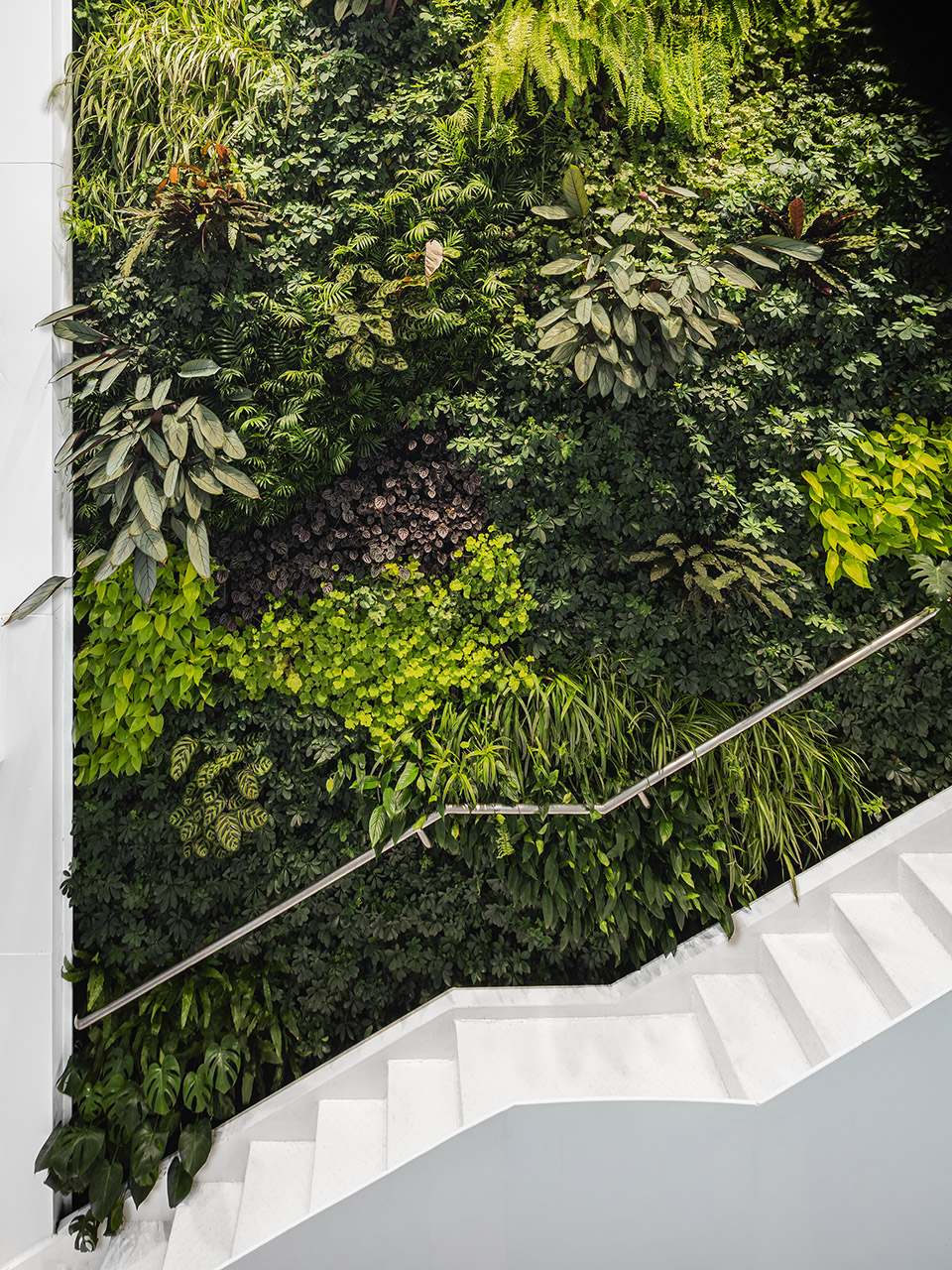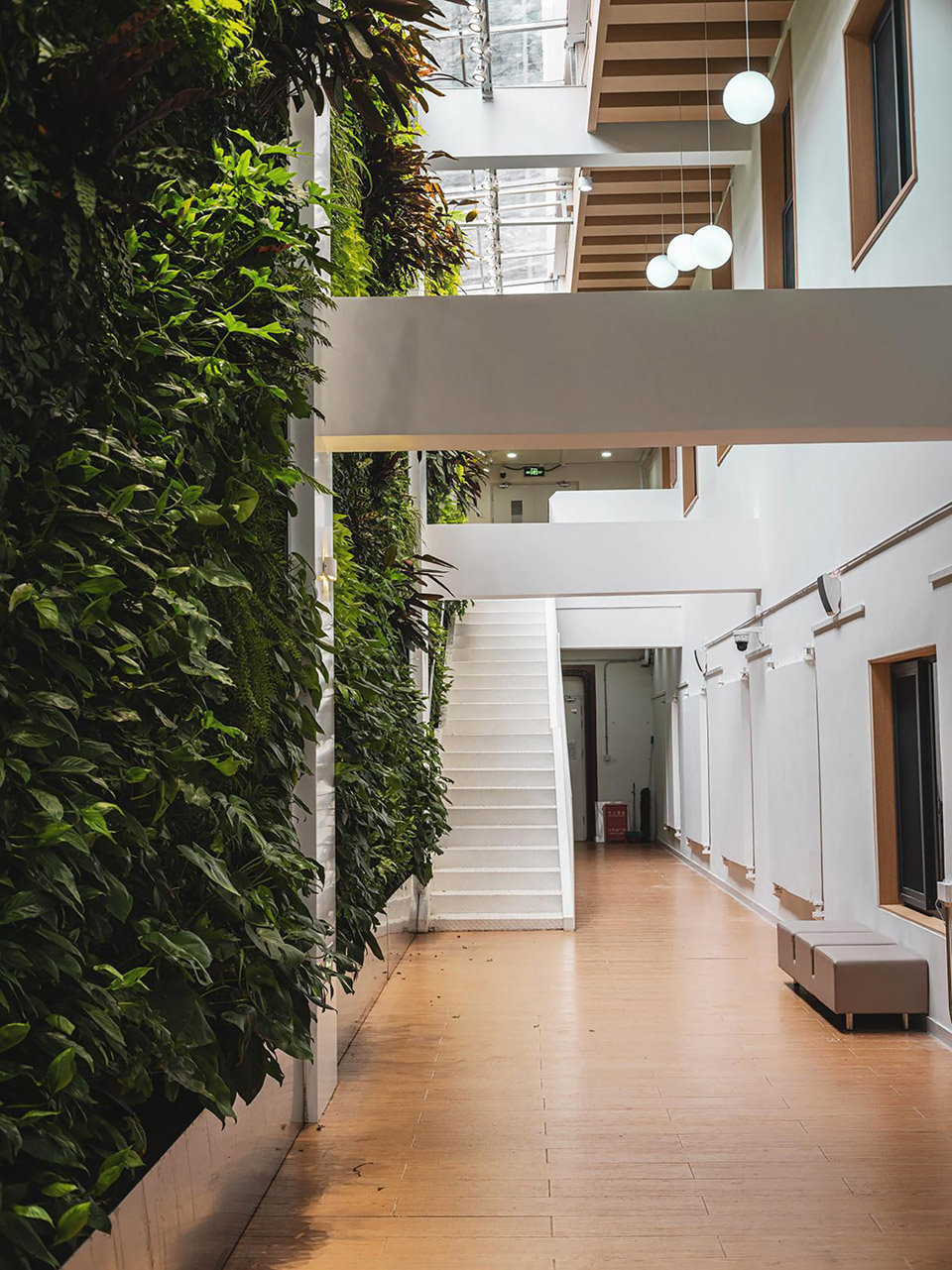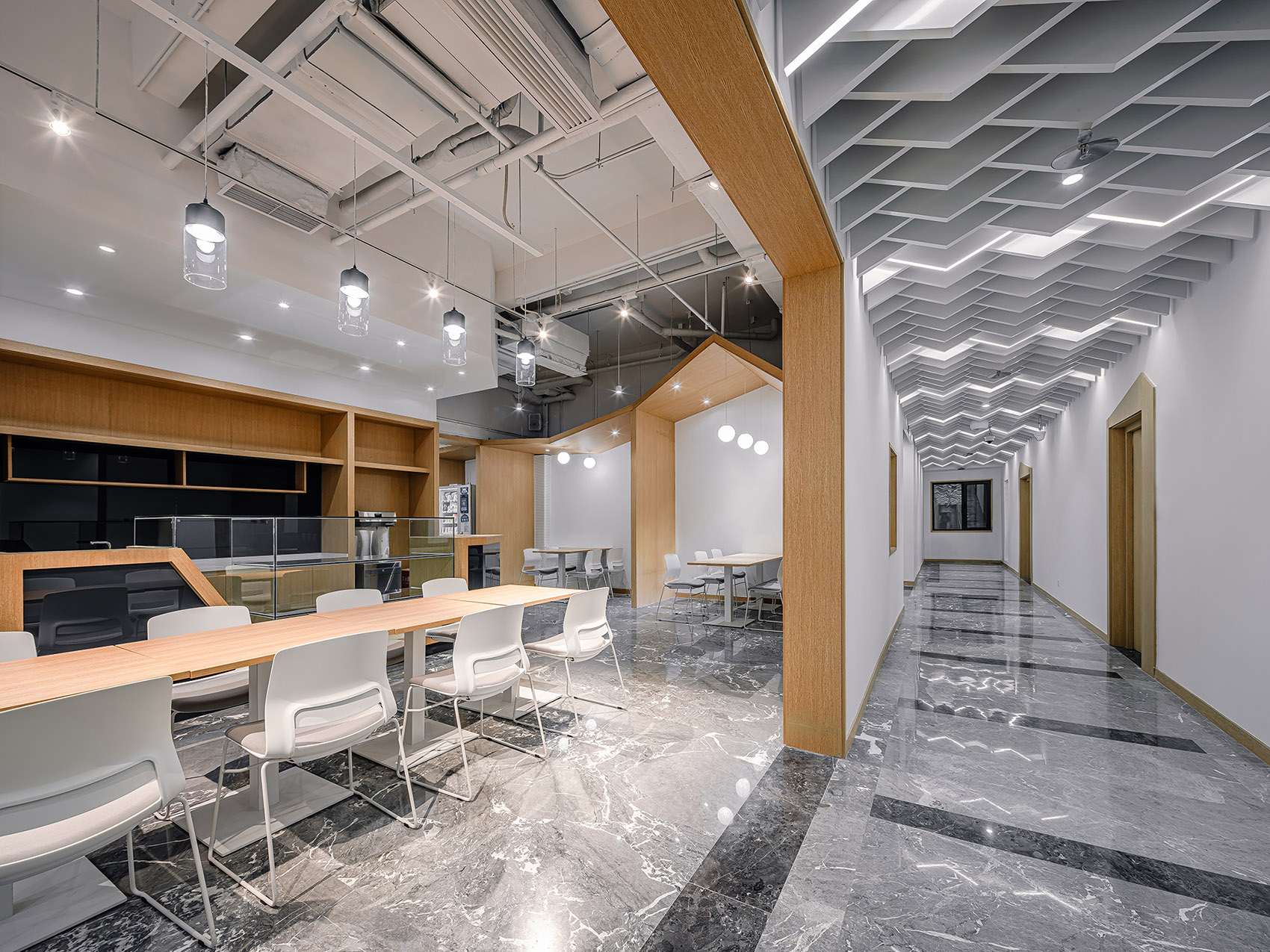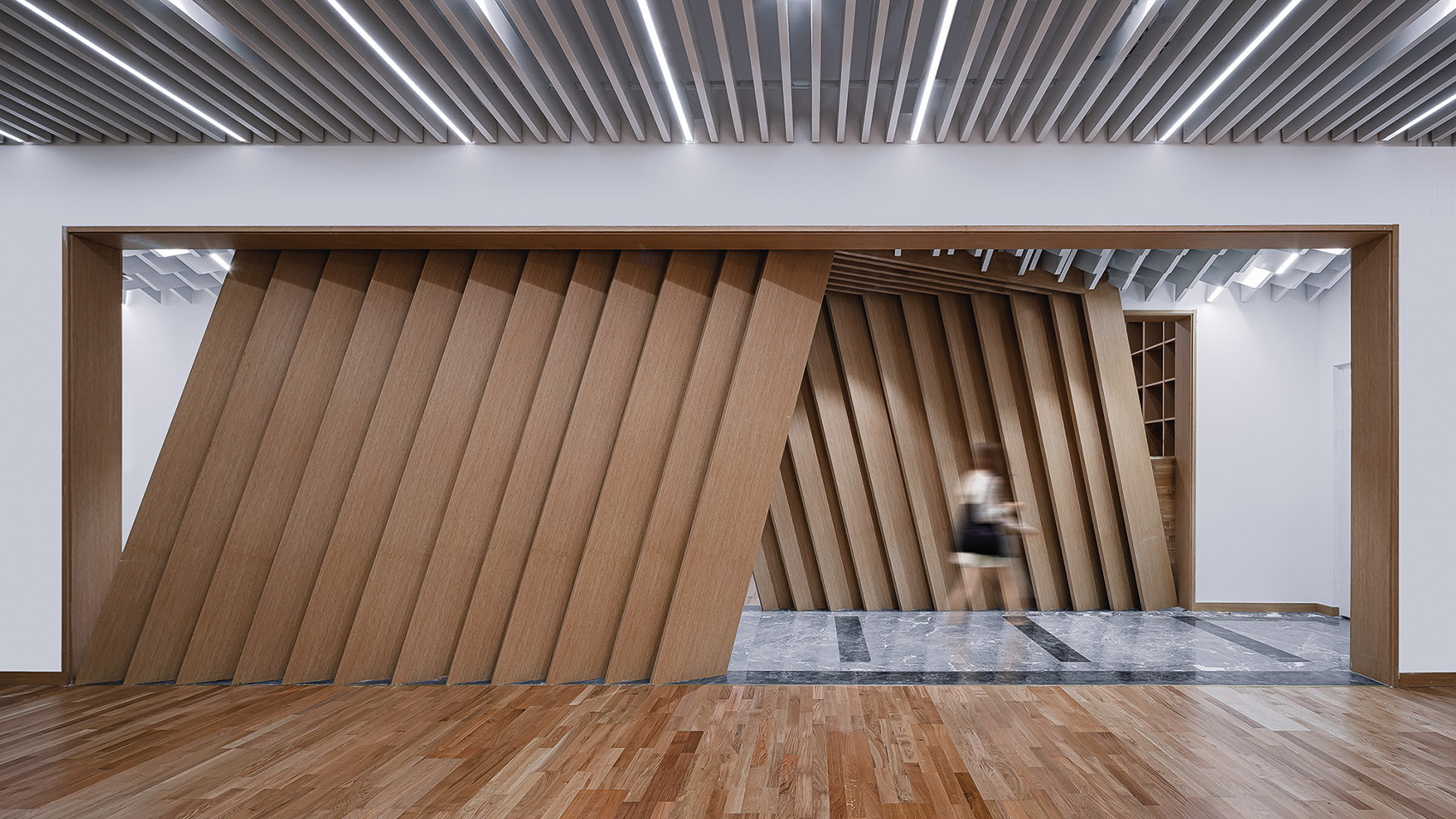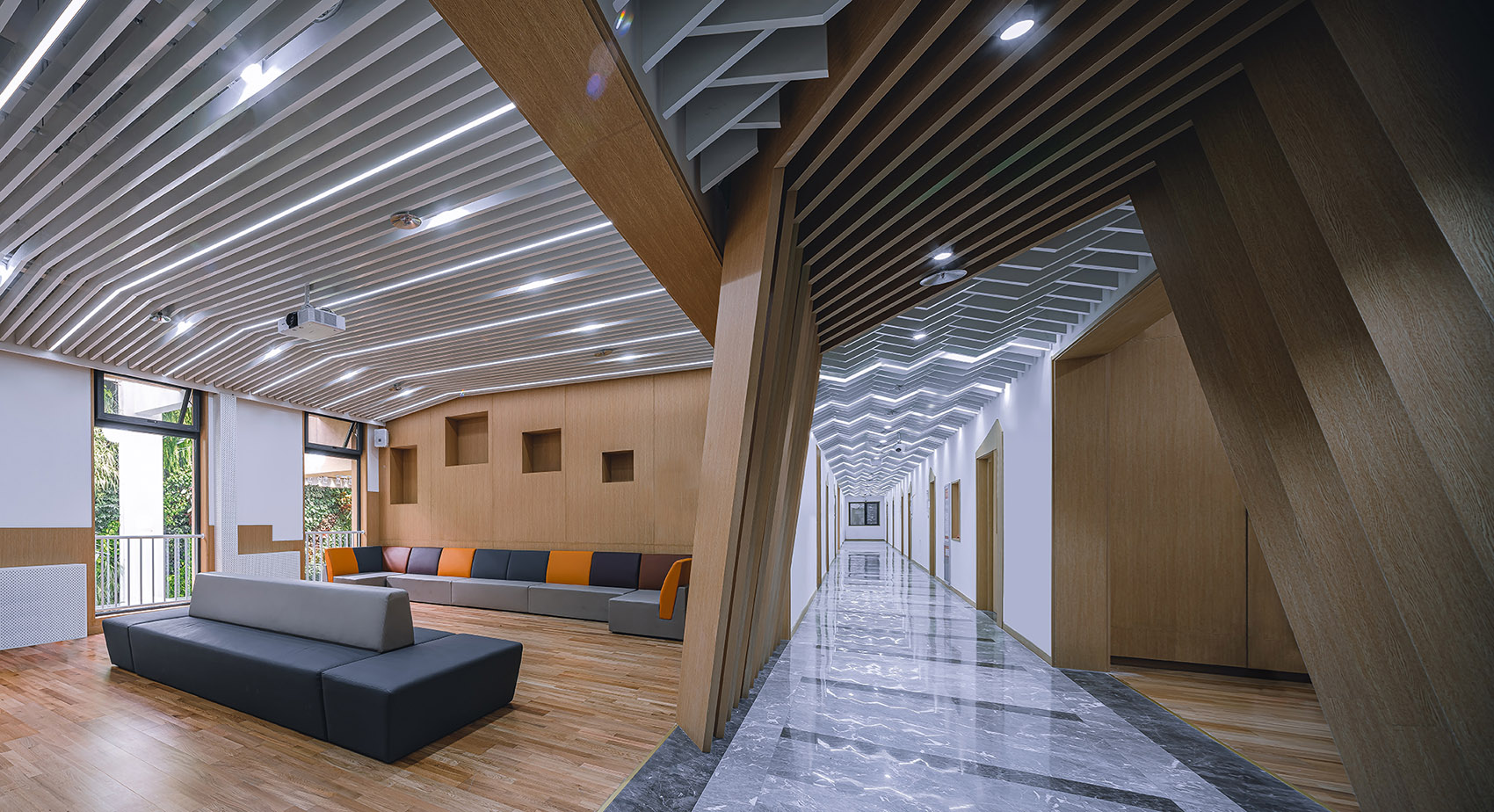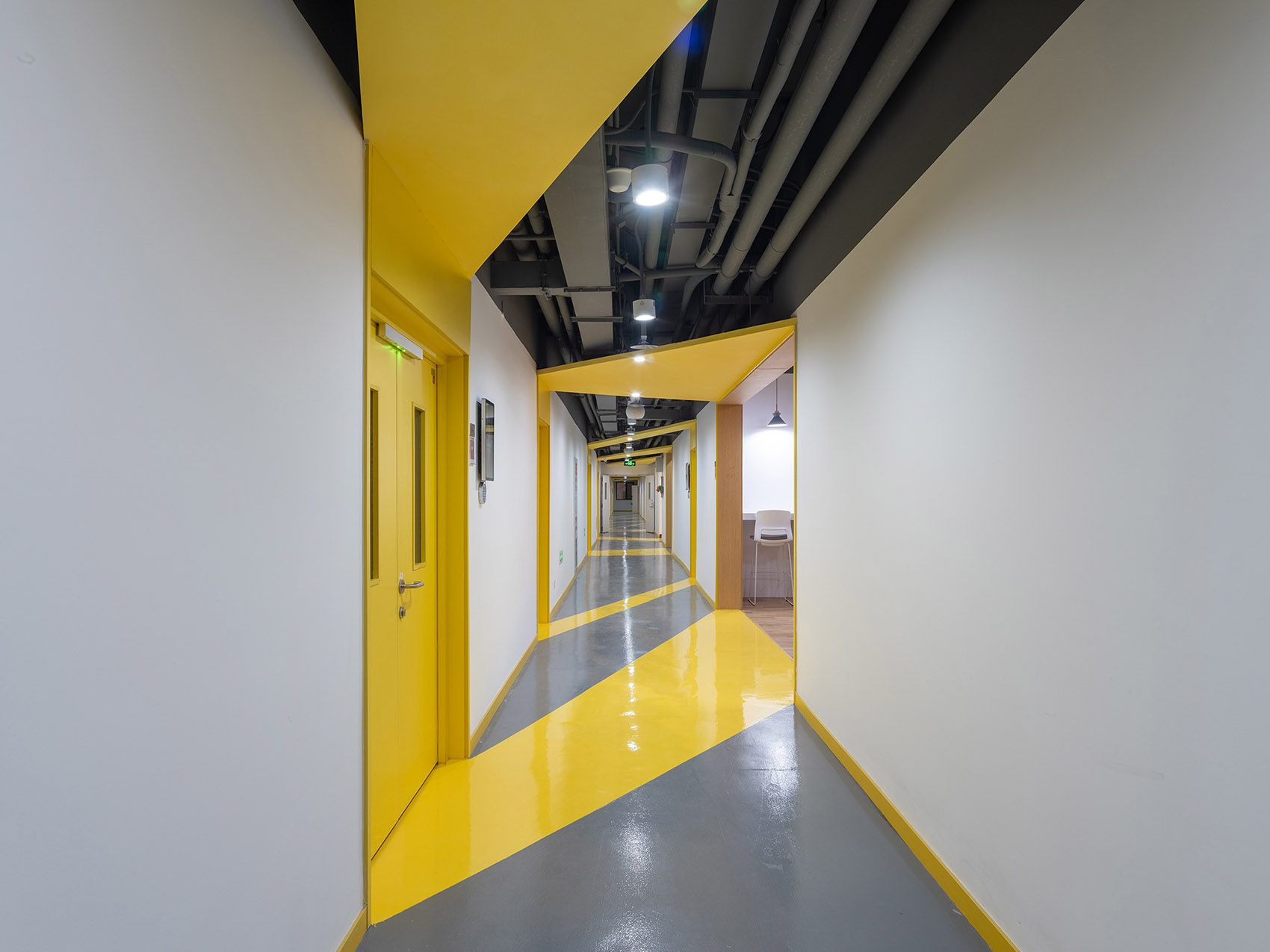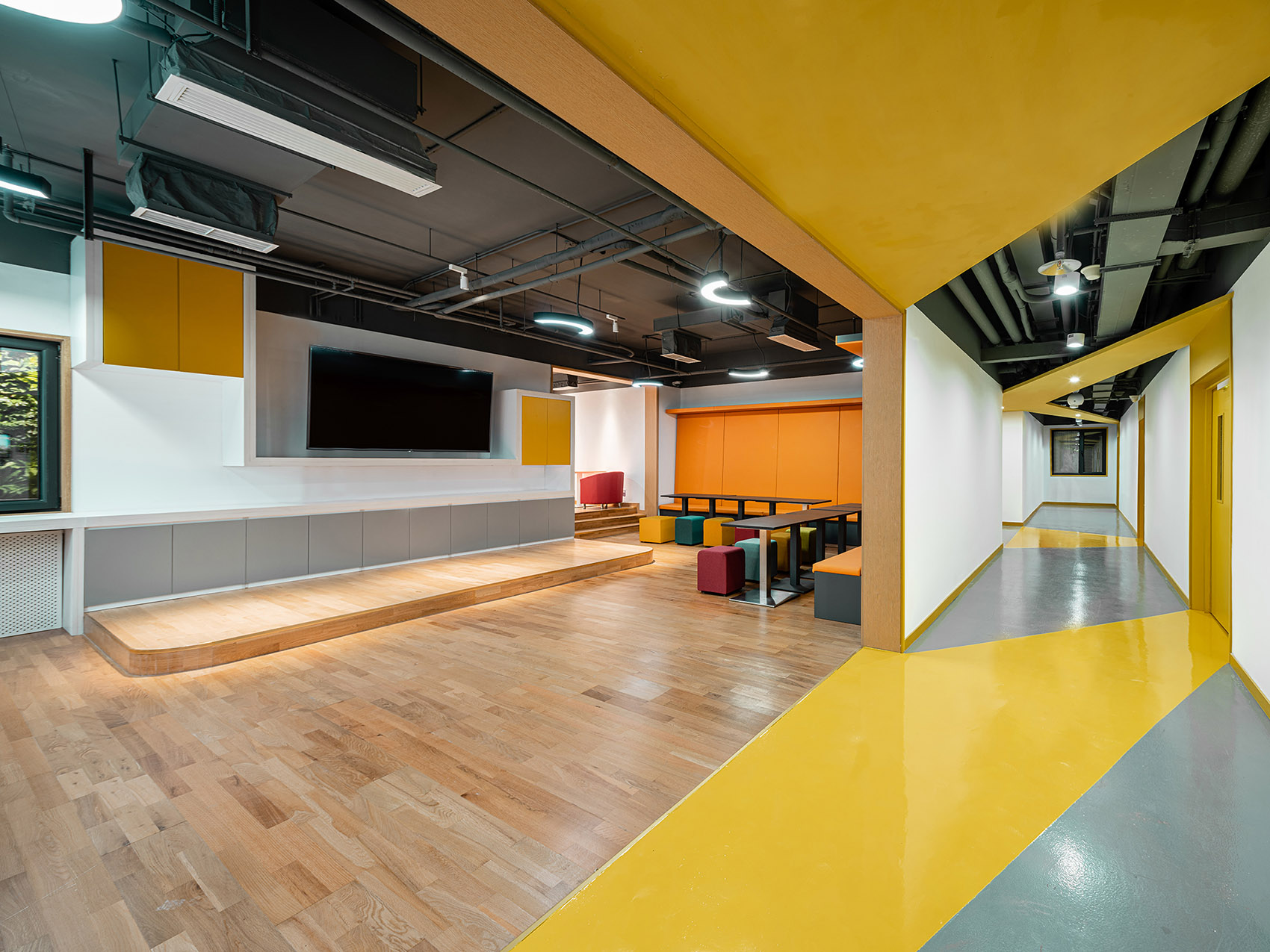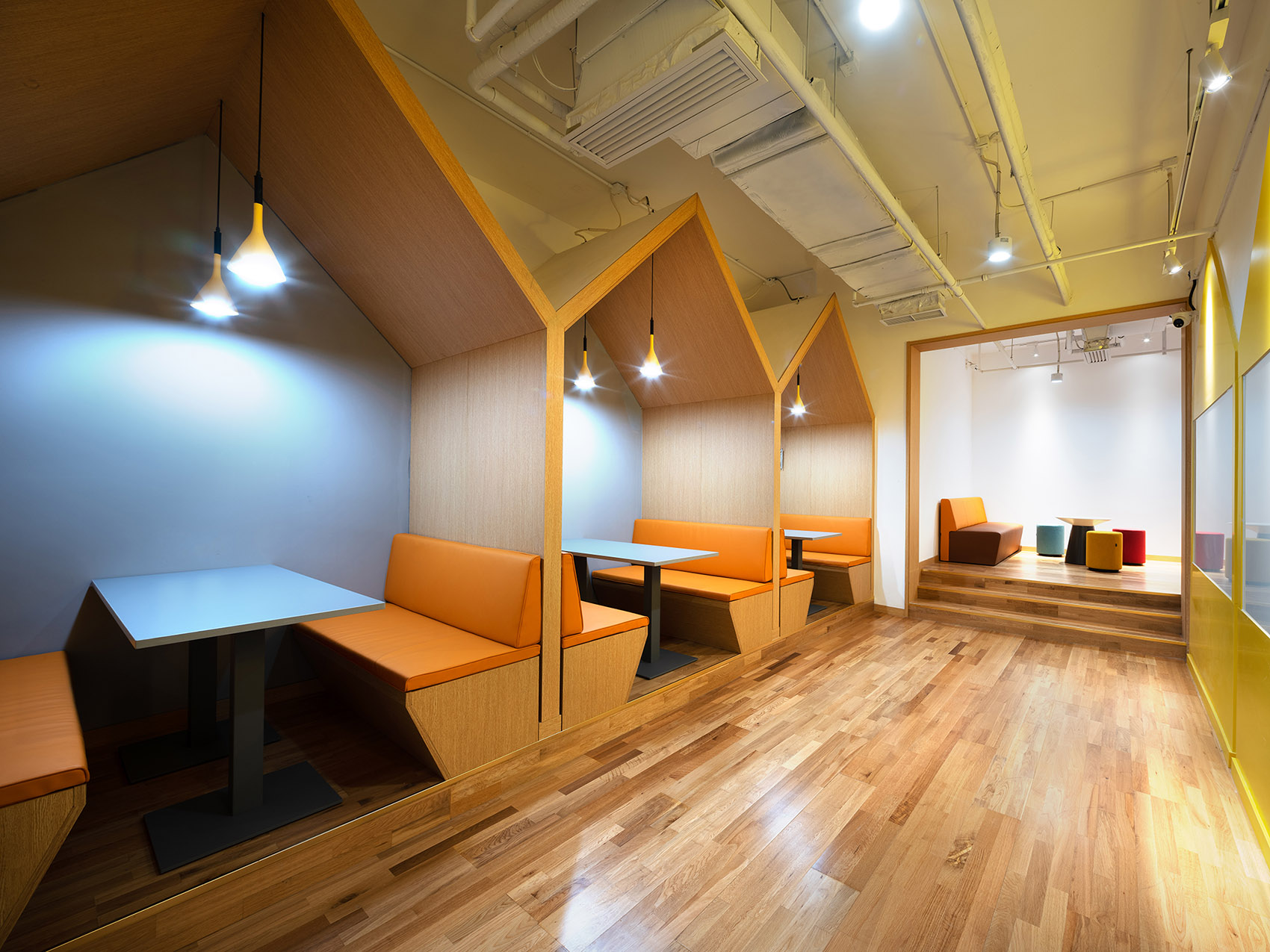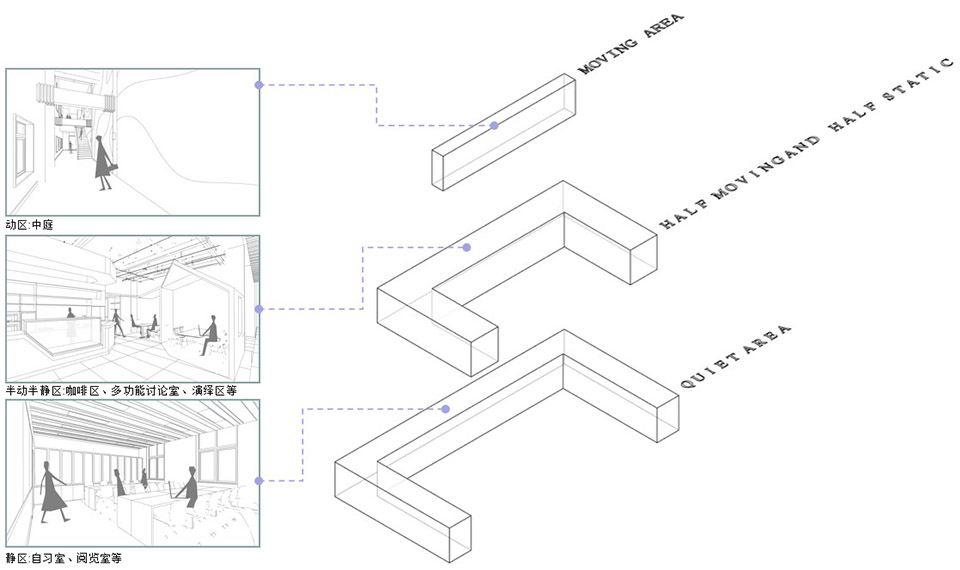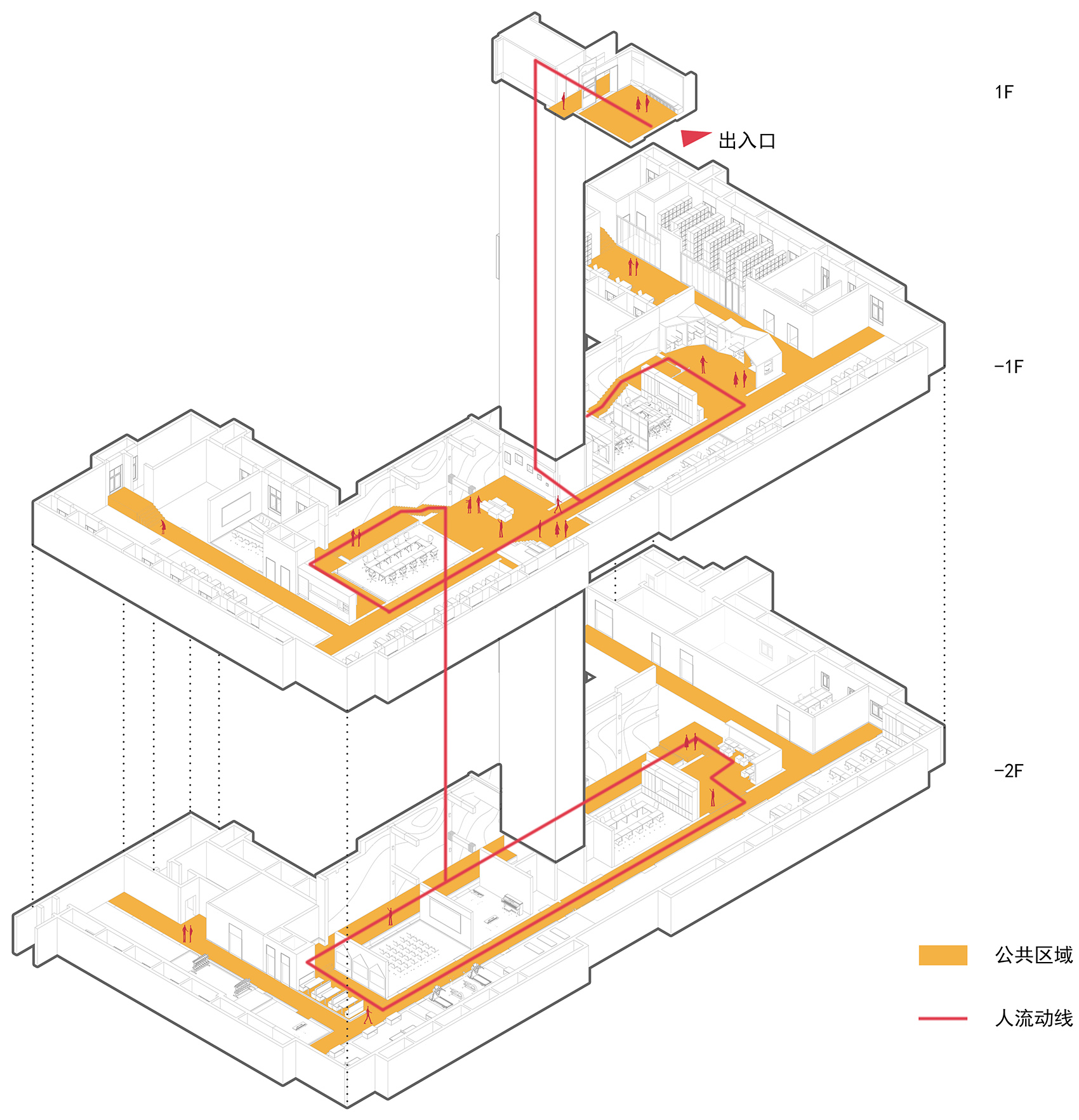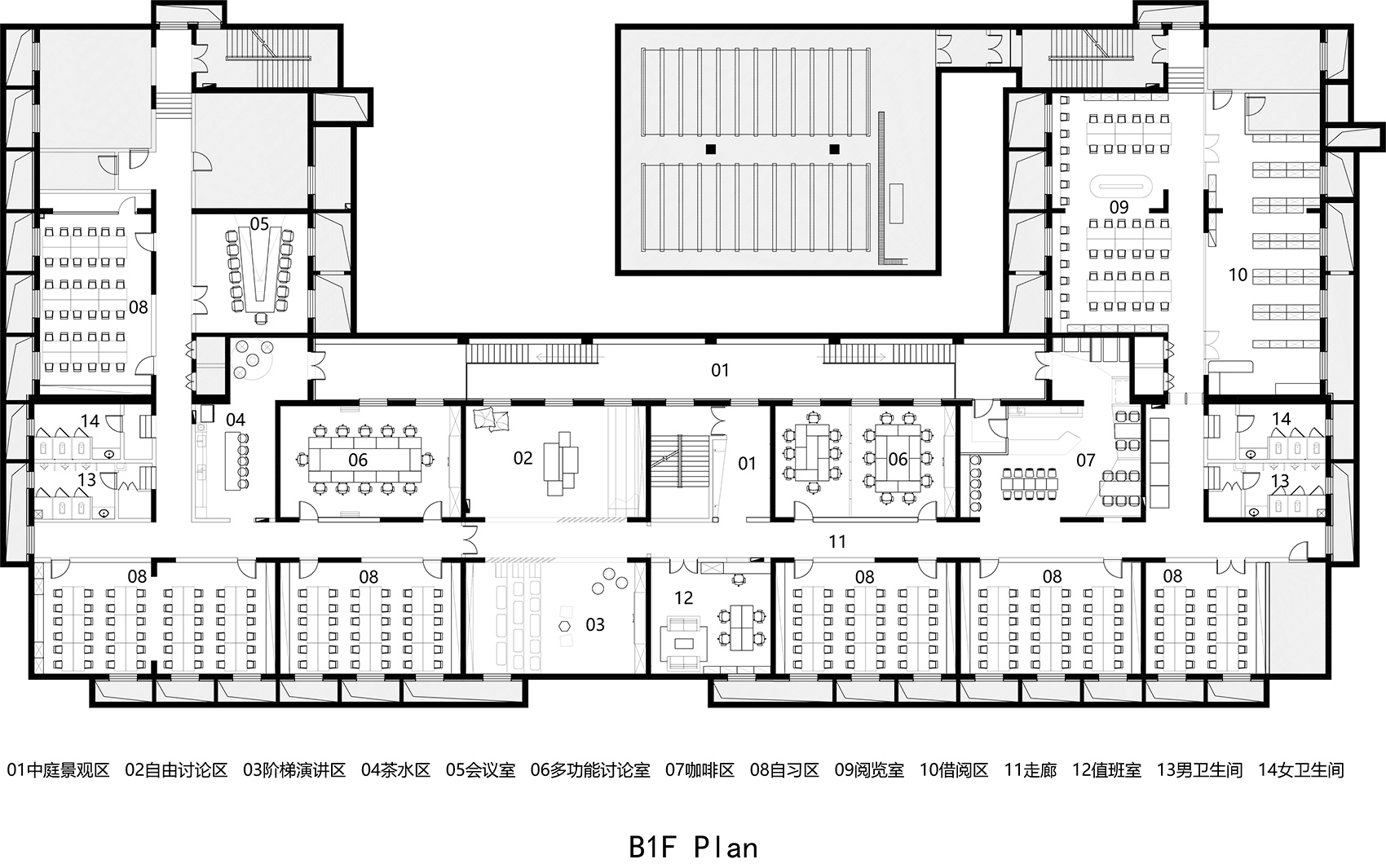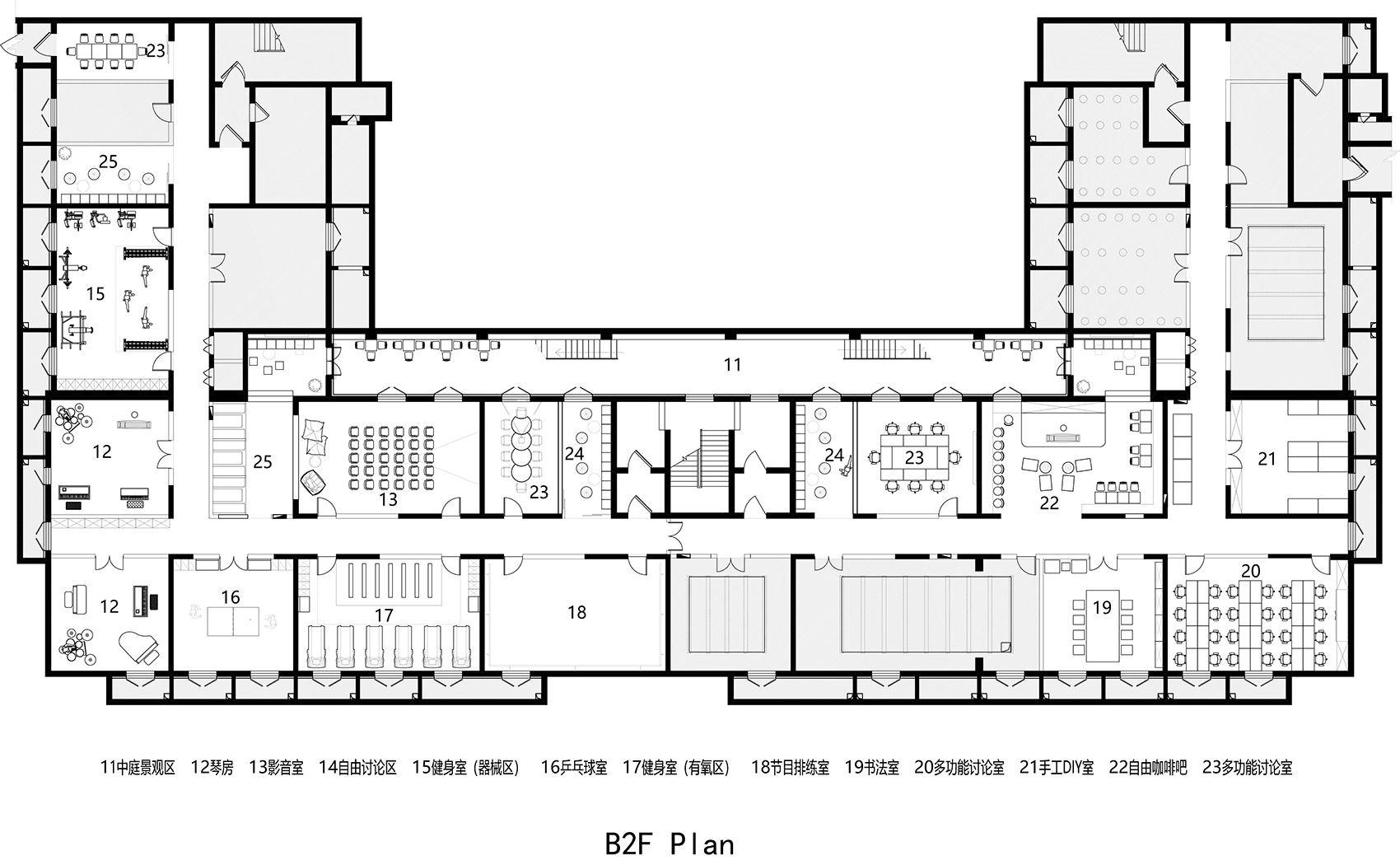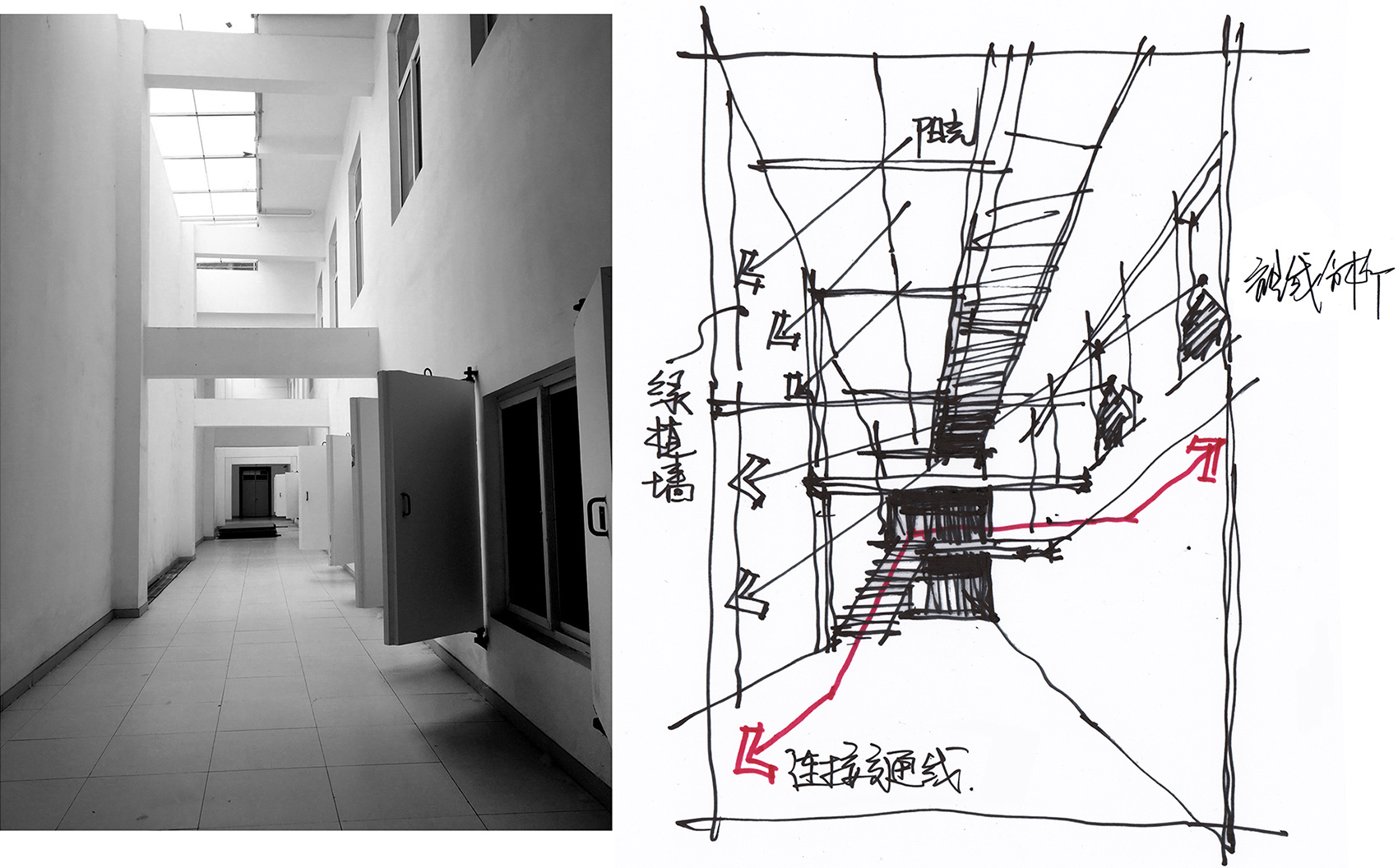北大35号宿舍楼地下空间的改造,重视从生活配套、情感体验、思想交流等不同维度,满足在此居住的学子们多层次的需求。设计理念以“交流”为核心,创造出功能配套齐全、理性与浪漫并行的学习与生活场所。意图通过设计优化空间,创造社交机会,培育学术精神。
在生活配套上以住宿式书院为导向,设置自习室、讨论室、图书馆、咖啡吧、瑜伽室、健身房、琴房等学习与休闲空间,丰富校园生活;在情感体验上以青年人审美为导向,追求简约大方的空间感受,以采光中庭与绿植墙打破地下空间的刻板认知;在思想交流上建立空间连接,划分动静分区,实现多种模式的交流自由。“交流”的最大化、最优化实现是本方案设计的最初源点。
The goal of the transformation project, the upgrade of the underground space of dormitory building No. 35 of Peking University, is to meet the multi-level needs of the students living there. Great importance has been attached to different dimensions such as living facilities, emotional experience, and exchange of ideas. In this design, “communication” is taken as the core concept to create a place with complete functions, and full of rationality and romance for students’ learning and living. After the design, it hopes that the underground space is to be optimized, social opportunities are to be created, and the academic spirit could be cultivated.
In terms of living facilities, accommodation academy is taken as the orientated mode. Equipped with learning and leisure spaces such as the study room, discussion room, library, coffee bar, yoga room, gymnasium, piano room, etc., the campus life could be enriched; in the aspect of emotional experience, young people’s aesthetic is chosen as the focus orientation, to pursue a spatial feeling of simplicity and elegance, and break the stereotype of underground space with the daylighting atrium and green-plant walls; in the part of idea exchange, spatial connections are established, dynamic and static partitions of the space are divided, and the freedom of communication in multiple modes is realized. To maximize and optimize the “communication” process is the origin of this design.
▼项目概览,Project overview ©周涵滔

跨学科的汇聚,思想的碰撞,都需要特定的空间承载,35号楼地下空间的改造,基于交流模式划分出“律动—半动半静—安静”三个空间层次。
由中庭、植物墙、垂直楼梯共同构造的景观带,营造出充满活力的律动区域。地下空间的中庭,引入自然绿肺的概念,以欣欣向荣的植物墙,体现“生长”的精神。玻璃屋顶采光充沛,植物墙绿意盎然。学子可以扶栏而立,也可以席阶而坐,阳光的倾洒、晚星的闪烁、四季的交替,是大家侃侃而谈时最美的点缀。垂直楼梯,将负一层、负二层连接,构成一条流动、错落的环形路径。它让两层之间不再难以跨越,提高了使用便利性。在这里,阳光洒下、植物蔓延,室内外的空间区别变得模糊,地下空间的封闭感不复存在,良好的空间品质增进了交流的频次。上下之间,左右之中,或许擦肩而过的瞬间,就促成了一场有趣的思想交流。
The convergence of interdisciplinary fields and the collision of different ideas both require the specific space to happen. To fulfill such aims, the transformation design is based on the communication pattern to divide the underground space of Building 35 into three spatial types, as “rhythm space- semi dynamic and semi quiet space- quiet space”.
The landscape belt jointly constructed by the atrium, plant wall, and vertical stair creates a vibrant and rhythmic area. The atrium of the underground space introduces the concept of natural green lung, and the thriving plant wall reflects the spirit of “growth”. The glass roof is of plenty lighting and the plant wall is full of green. Students could stand on the railings or sit on the steps. The pouring of sunlight, the twinkling of evening stars, and the alternating of four seasons are the most beautiful scenes when everyone talks easily and fluently. Improving the convenience of use, the vertical stair connects the first underground floor and the second underground floor to form a flowing and scattered circular path, which makes it no longer difficult to cross between the two layers. Here, the sunshine pours and plants spread, the spatial distinction between indoor and outdoor becomes blurred, the sense of closeness of the underground space is no longer in existence, and the good spatial quality increases the frequency of communication. Perhaps the brush past moment is contributed to an interesting ideological exchange of the students between the up and the down, the left and the right.
▼ 人流动线分析图,Crowd flow analysis diagram ©张玉伟
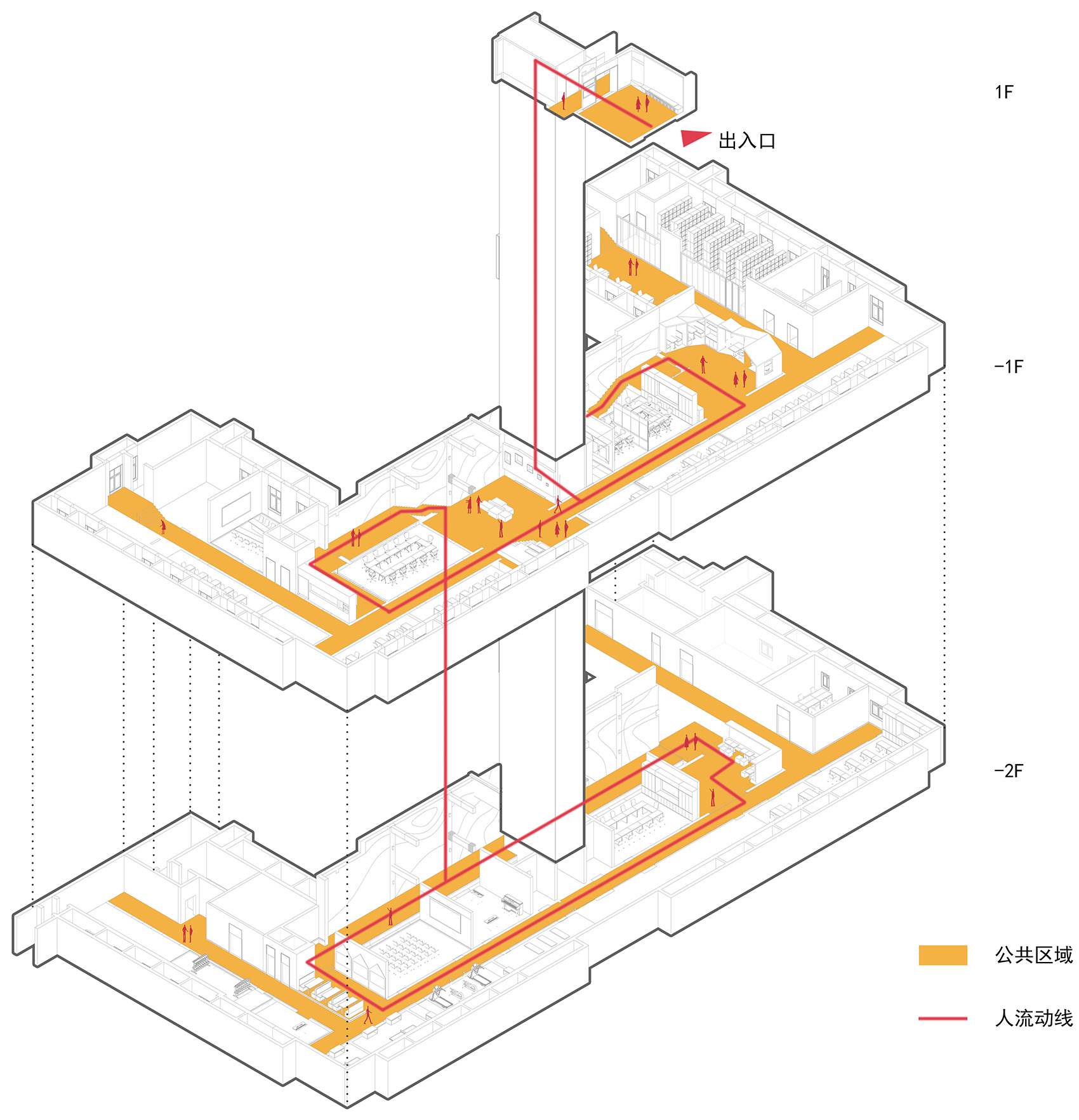
顺着律动的节奏,沿着环形路径顺次展开的,是半动半静、安静两个功能区。负一层负二层的半动半静区域,包括阶梯演讲室、演艺区、咖啡吧、讨论室等各种公共空间。功能灵活可变,为正式交流、非正式交流、深度探讨提供了多种组合模式,让各种交流得到充分的支持。唇枪舌剑与轻声漫语之间,转眼便见窗外的绿植,一扇扇“绿窗”,见证着思想的成长。
树屋与各层廊道衔接动区、半动半静区与安静区。树屋提供一个适合三两人的交流与学习的区域,舒适而开放。而当想法需要沉淀的时候,走进自习室与图书馆,瞬间由动转静,心自然也就跟着静了下来。
律动、半动半静、安静的节奏变化,使空间变得更有层次,使交流更加深入。在这里师生都能够找到最适合自己的一处天地。
行为影响设计,设计塑造空间,空间引导行为,随着35号楼的改造完成,在这里学习、生活、交流的师生,也将在这个全新的公共空间中,通过时间积淀形成元培学院独特的文化氛围。
Following the rhythm and unfolding sequentially along the circular path, there are two functional areas, semi dynamic and semi quiet space and quiet space. These two areas are located on the first and the second underground floors, including various public spaces such as stepped lecture room, performing arts area, coffee bar, and discussion room. The functions of these spaces are flexible and changeable, which provide a variety of combinations for formal and informal communications, and deep discussion to support various kinds of interactions. The green plants outside the window could be seen in the twinkling of an eye between fiercely debating and mildly speaking , and the “green windows” witness the growth of thoughts.
The dynamic area, the semi dynamic and semi quiet area and the quiet area are connected by the tree house and the corridor on each floor. The tree house provides a comfortable and open area for two or three people to communicate and study. When the idea needs to be settled, the disturbance is turned into quiet in an instant when walking into the study room and library, and the mind naturally calms down.
The dynamic, semi dynamic and semi quiet, and quiet changes of the rhythm make the space more layered and the communication deeper. Teachers and students could find the place most suitable for them.
Behavior influences design, design creates space, and space guides behavior. After the completion of the transformation of Building 35, the teachers and students who study, live, and communicate here will also form a unique cultural atmosphere for Yuanpei College through the accumulation in the brand new space as time goes by.
▼中庭,Atrium ©周涵滔
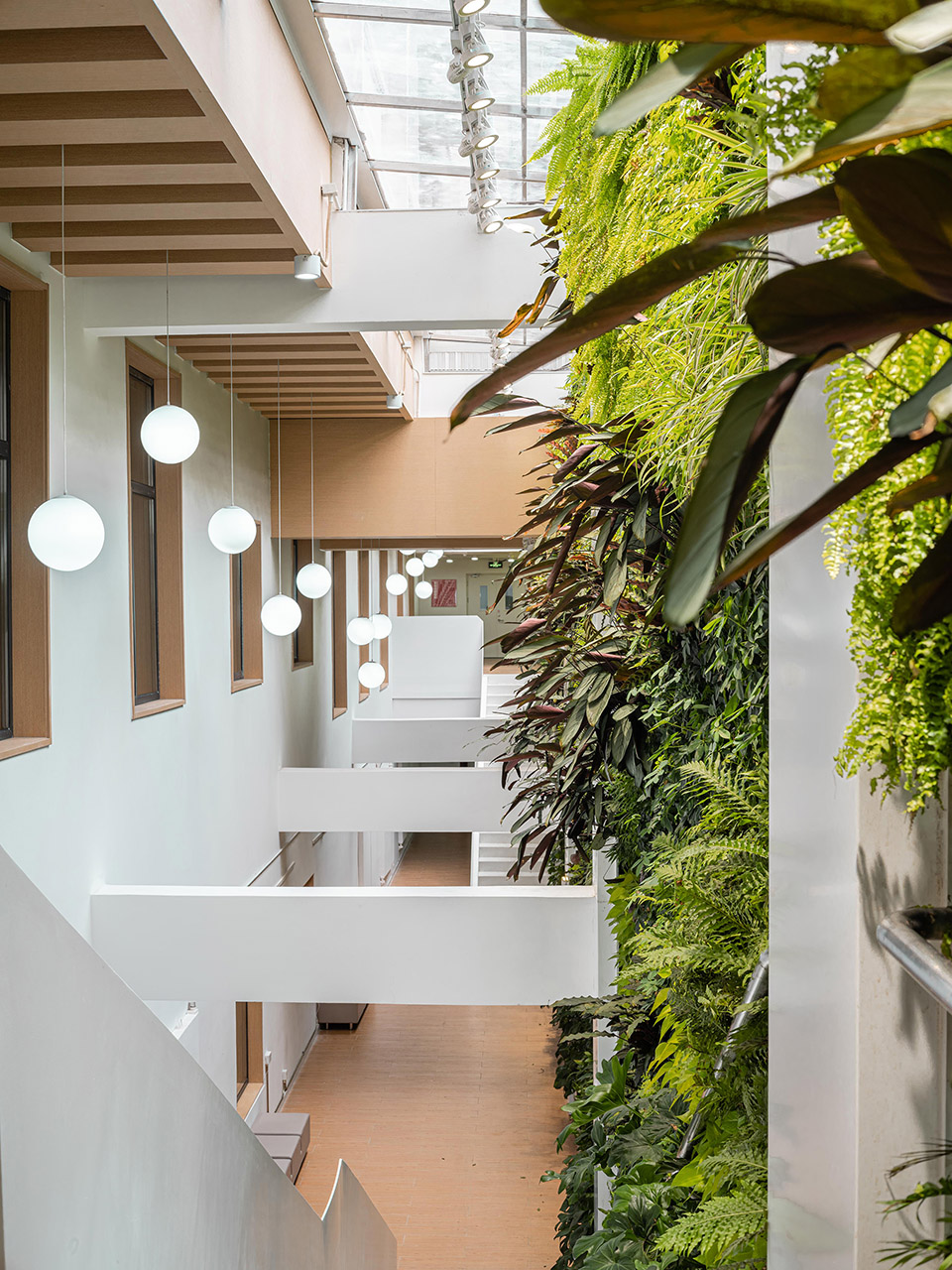
北京大学35号楼是元培学院的学生宿舍楼。元培学院践行住宿制书院理念,期望将宿舍楼改造成一个集生活与学习为一体的住宿综合体。然而,原宿舍配套空间不足,扩建与加建无法实现,唯有使用地下一层、地下二层等品质较差的空置空间。因此,我们对约3000平米的宿舍地下空间进行大幅改造。主要方式有:调整交通结构、划分动静区域、植入绿化景观、改善空气质量、提升空间品质等。营造出一个集住宿、学习、娱乐、交流为一体的住宿综合体。在宿舍楼里学生可以拥有自习室、咖啡厅、小讲堂、瑜伽室、健身房、电影院、琴房等多类型空间,让学习与生活相互交融。地下空间改造不仅提升了35号宿舍楼的配套水准,其服务面向校园,也提升了宿舍区的整体品质。针对目前高校普遍存在的配套空间不足等情况,地下空间的改造提升不失为一条有效的途径。
Building 35 of Peking University is the student dormitory of Yuanpei College. Yuanpei College wants to fulfill the residential college concept and expects to transform the dormitory into a residential complex which integrates the living and the learning. Whereas, the supporting facility space of original dormitory is insufficient, and expansion and addition of the space could not be realized. Only the unoccupied spaces of poor quality could be used, such as the first and the second underground floors. Therefore, we have greatly transformed the underground space, about 3000 square meters of the dormitory. The following modes are adopted in the transformation: adjust the traffic structure, divide dynamic and static areas, plant green landscapes, improve air quality, and enhance the space quality. Through these methods, an accommodation complex integrating accommodation, learning, entertainment and communication is created. In the dormitory building, students could have study rooms, coffee houses, small lecture halls, yoga rooms, gymnasiums, cinemas, piano rooms and other types of spaces, which mingle the learning with the living. The underground space transformation not only improves the supporting facility standards of dormitory building No. 35, but also improves the overall quality of the dormitory area as its services are oriented to the campus. Facing the insufficient situation of supporting facility space in colleges and universities currently, the transformation and upgrading of underground space could be an effective way.
▼ 功能体块分析图,Functional analysis diagram ©张玉伟
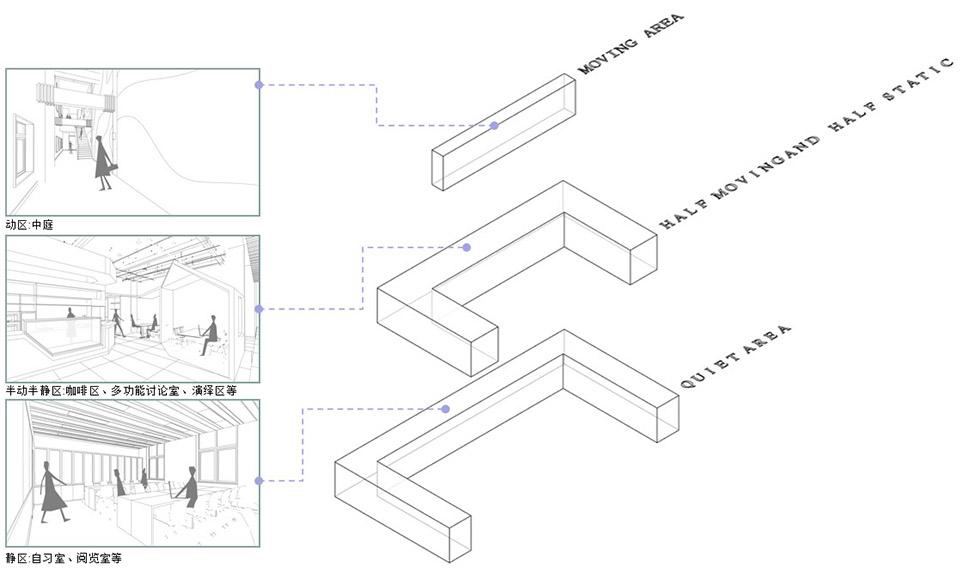
中庭、植物墙、垂直楼梯共同构造的景观带,营造出充满活力的律动区域。地下空间的中庭,引入自然绿肺的概念,以欣欣向荣的植物墙,体现“生长”的精神。玻璃屋顶采光充沛,植物墙绿意盎然。学子可以扶栏而立,也可以席阶而坐,阳光的倾洒、晚星的闪烁、四季的交替,是大家侃侃而谈时最美的点缀。
▼中庭改造概念,Atrium transformation concept ©郑昌辉

The landscape belt jointly constructed by the atrium, plant wall, and vertical stair creates a vibrant and rhythmic area. The atrium of the underground space introduces the concept of natural green lung, and the thriving plant wall reflects the spirit of “growth”. The glass roof is of plenty lighting and the plant wall is full of green. Students could stand on the railings or sit on the steps. The pouring of sunlight, the twinkling of evening stars, and the alternating of four seasons are the most beautiful scenes when everyone talks easily and fluently.
▼中庭,Atrium ©周涵滔
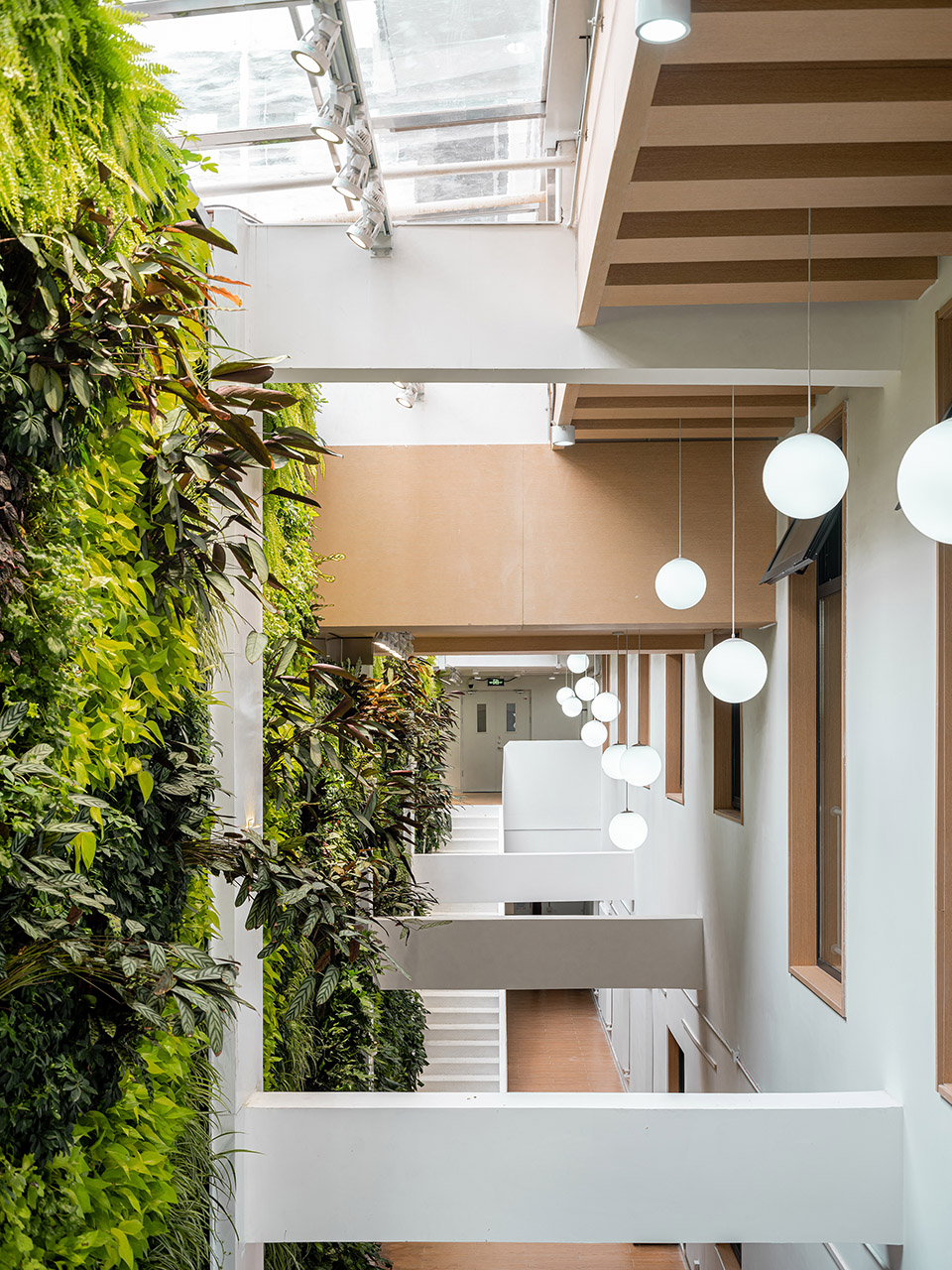
垂直楼梯,将负一层、负二层连接,构成一条流动、错落的环形路径。它让两层之间不再难以跨越,提高了使用便利性。在这里,阳光洒下、植物蔓延,室内外的空间区别变得模糊,地下空间的封闭感不复存在,良好的空间品质增进了交流的频次。上下之间,左右之中,或许擦肩而过的瞬间,就促成了一场有趣的思想交流。
Improving the convenience of use, the vertical stair connects the first underground floor and the second underground floor to form a flowing and scattered circular path, which makes it no longer difficult to cross between the two layers. Here, the sunshine pours and plants spread, the spatial distinction between indoor and outdoor becomes blurred, the sense of closeness of the underground space is no longer in existence, and the good spatial quality increases the frequency of communication. Perhaps the brush past moment is contributed to an interesting ideological exchange of the students between the up and the down, the left and the right.
▼ 绿植墙,Green-plant wall ©周涵滔

-1F层,铝板吊顶的天花,由一座座山峦交叠一般的几何造型组成,如同多学科交叠、各专业人才“小荷露尖角”一样,浅灰的地面、深灰色的石材造型,如同琴键,伴随师生踏步前行。
-2F floor, the embellishment of the aluminum-plate ceiling, is composed of the geometric shapes of overlapping mountains, just like the overlapping status of multi-disciplinary fields and the professional talents performing as ” The Lotus Just Showing Its Sharp Bud “. The light gray ground and the dark gray stone accompany the teachers and students to move forward as piano keyboards.
▼ 咖啡区,Coffee area ©周涵滔
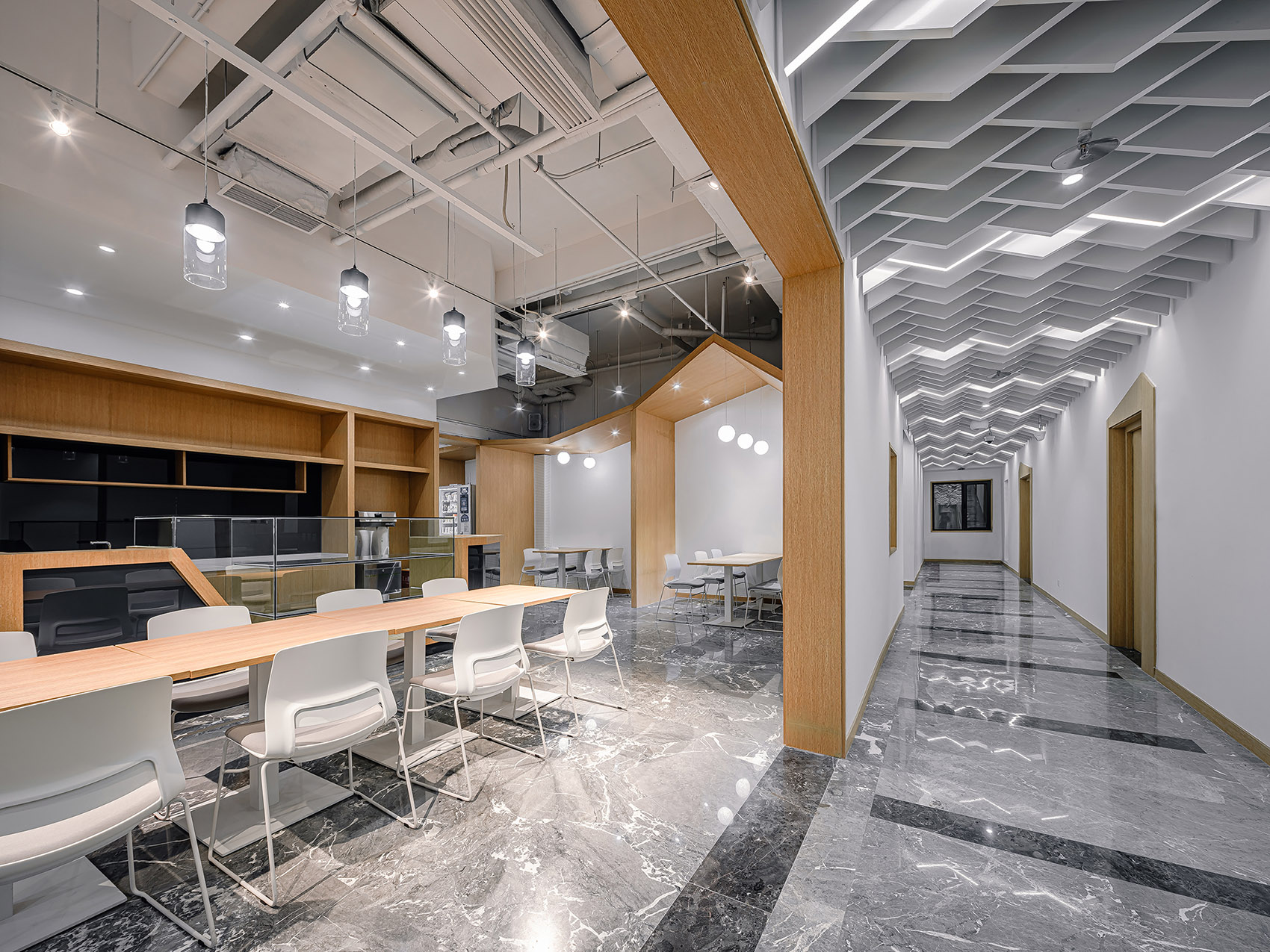
阶梯演讲、自由讨论区、讨论室,为正式交流、深度探讨提供了平台。唇枪舌剑之间,一转身便可看到窗外的绿植,一扇扇“窗景”,见证着思想的萌芽与成长。
书页式隔断,位于两个阶梯教室之间,营造出半隐半透的朦胧感。从教室走出,转到走廊,灯光点点,似乎行走在山海之间,往前走,往后走,视觉变化尽在其中。
The stepped lecture room, free discussion area, and discussion room provide a platform for deeper discussion. The green plants outside the window could be seen in the twinkling of an eye between fiercely debating and mildly speaking, and the “green windows” witness the growth of thoughts.
Located between the two stepped classrooms, the page like partition creates a hazy feeling, which is half hidden and half apparent. Walking out of the classroom and turning to the corridor, the lights are dotted, seeming like walking between the mountains and the sea. Walking forward, walking backward, the visual changes are all in them.
▼阶梯演讲区,Stepped lecture room ©周涵滔
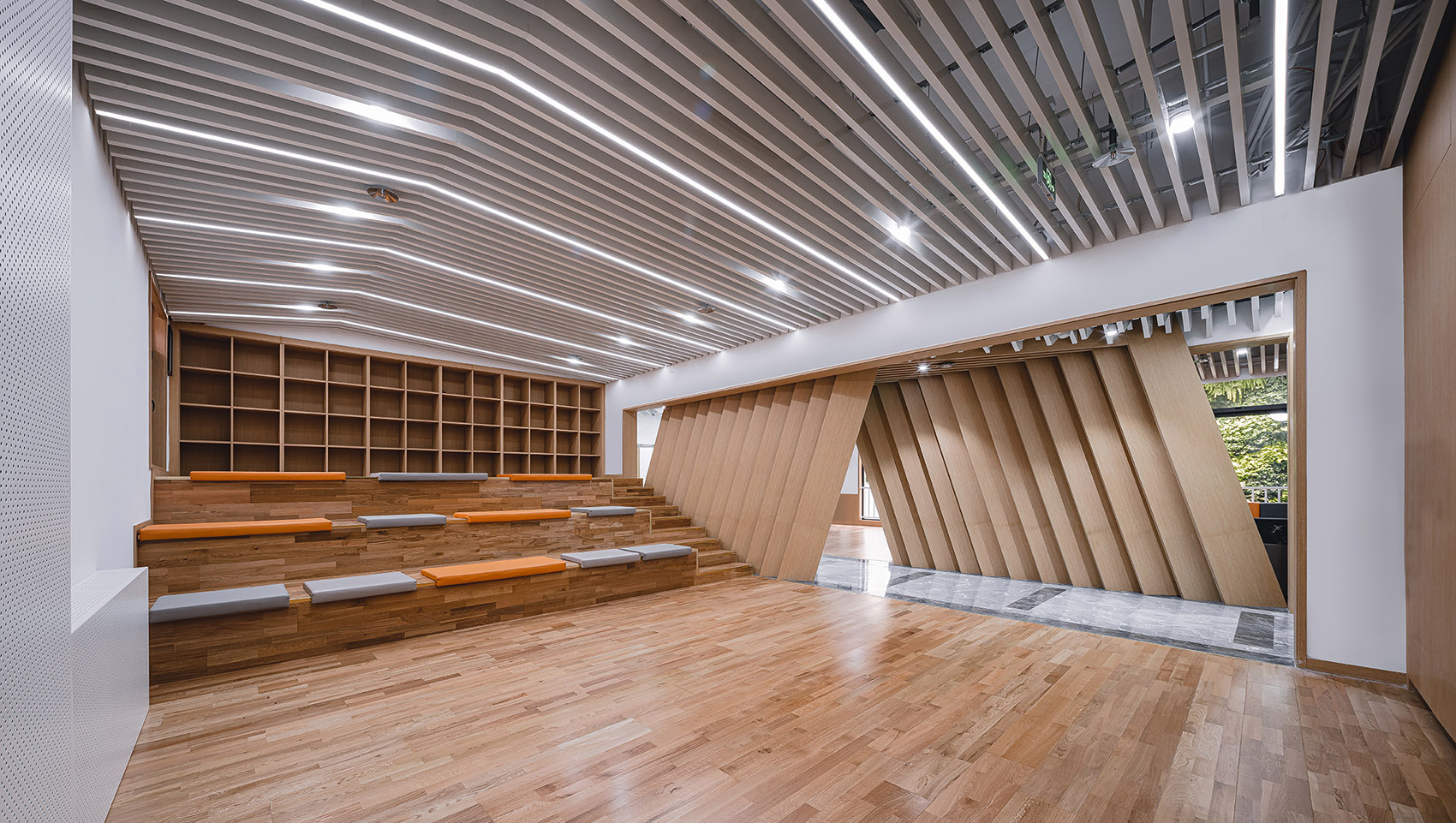
▼ 书页式隔断,Partition like book page ©周涵滔
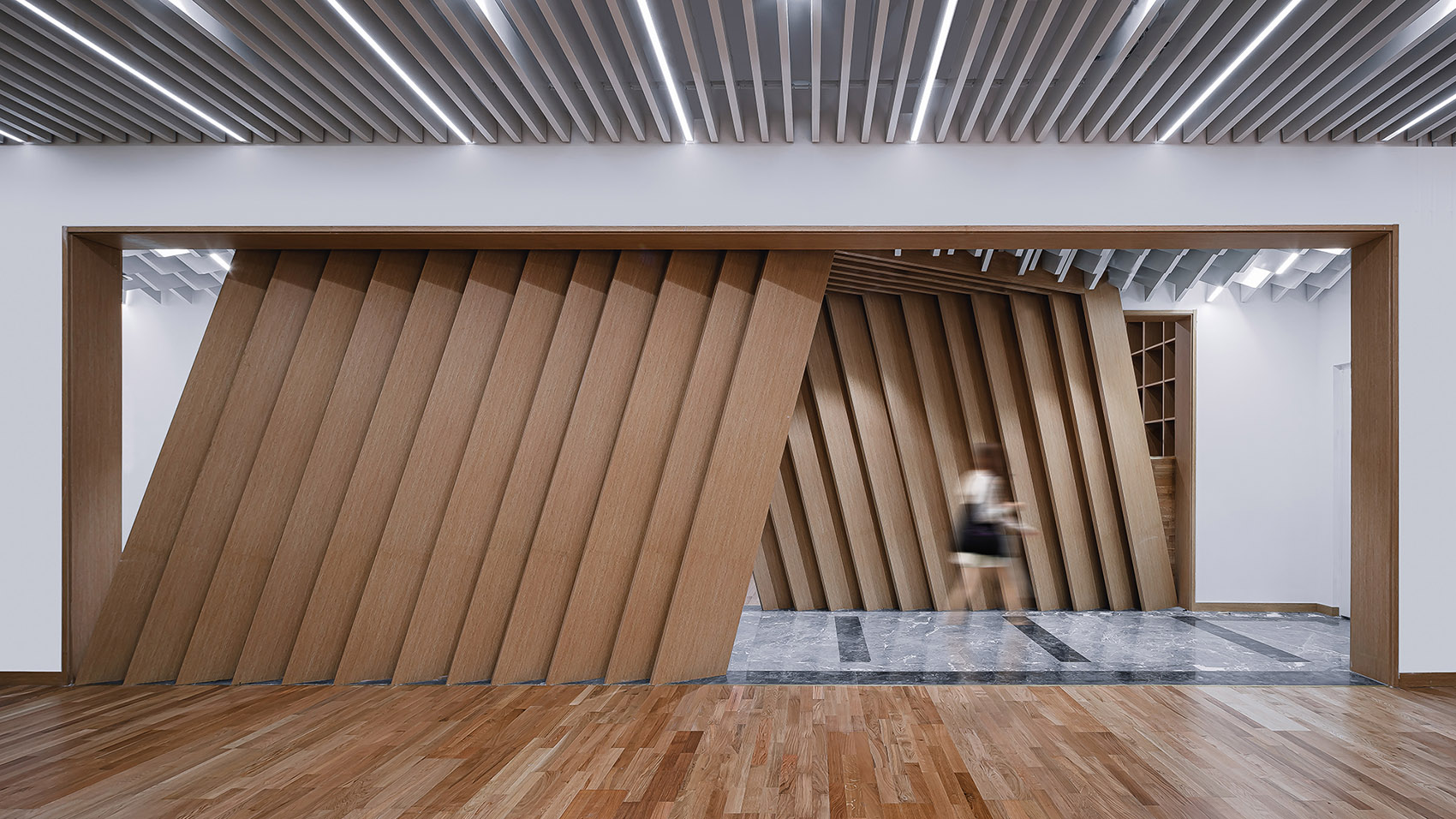
▼ 自由讨论区,Free discussion area ©周涵滔

▼ 多功能讨论室,Multifunctional discussion room ©周涵滔

-2F层,明亮跃动的色块贯穿-2F走廊,一条条衔接线,延展开来,将行走其中的人们引向每一个空间,让跃动的步伐在亮丽的指引中井然有序,延展开来。
-2F floor, the bright and vibrant color blocks run through the -2F corridor, and the connecting lines are extended to lead people to walk into each space, so that the pulsating steps are orderly organized and unfolded under the bright guidance.
▼-2F走廊,-2F Corridor ©周涵滔
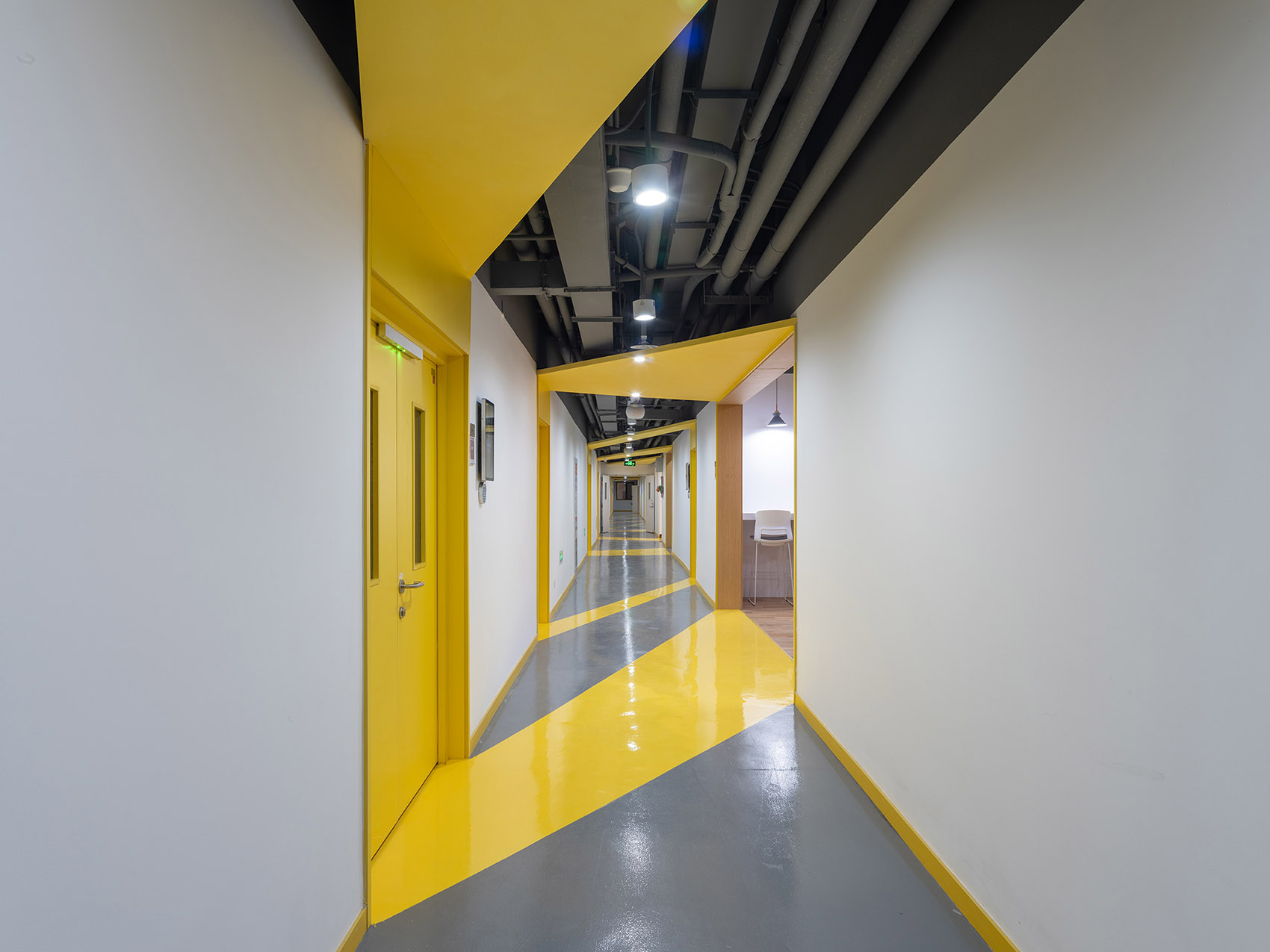
-2F的演绎区,提供了才艺展示小型讨论的舞台,学子可坐可立,或停驻,或走动,随心而定,是汇聚、展示、小型聚会的一个空间。
-2F树屋,连接景观廊道,衔接律动和半动半静区,像一条大自然里的通道,提供一个自然形态下的学习区域,适合三两人,用来等待、看书、交流,静谧而开放。
-2F floor, the performing arts area, provides a stage for small discussion and talent show, where students can sit and stand, stop and walk around, or whatever they want. It is a space for gathering, displaying and small meeting.
-2F tree house, connecting the landscape corridor and jointing dynamic areas and semi dynamic and semi quiet areas. It’s like a passageway in the nature, and provides a learning space with a natural form for two or three people to wait, read and communicate with each other, quietly and openly.
▼-2F演绎区和树屋,-2F performing arts area & Tree house ©周涵滔
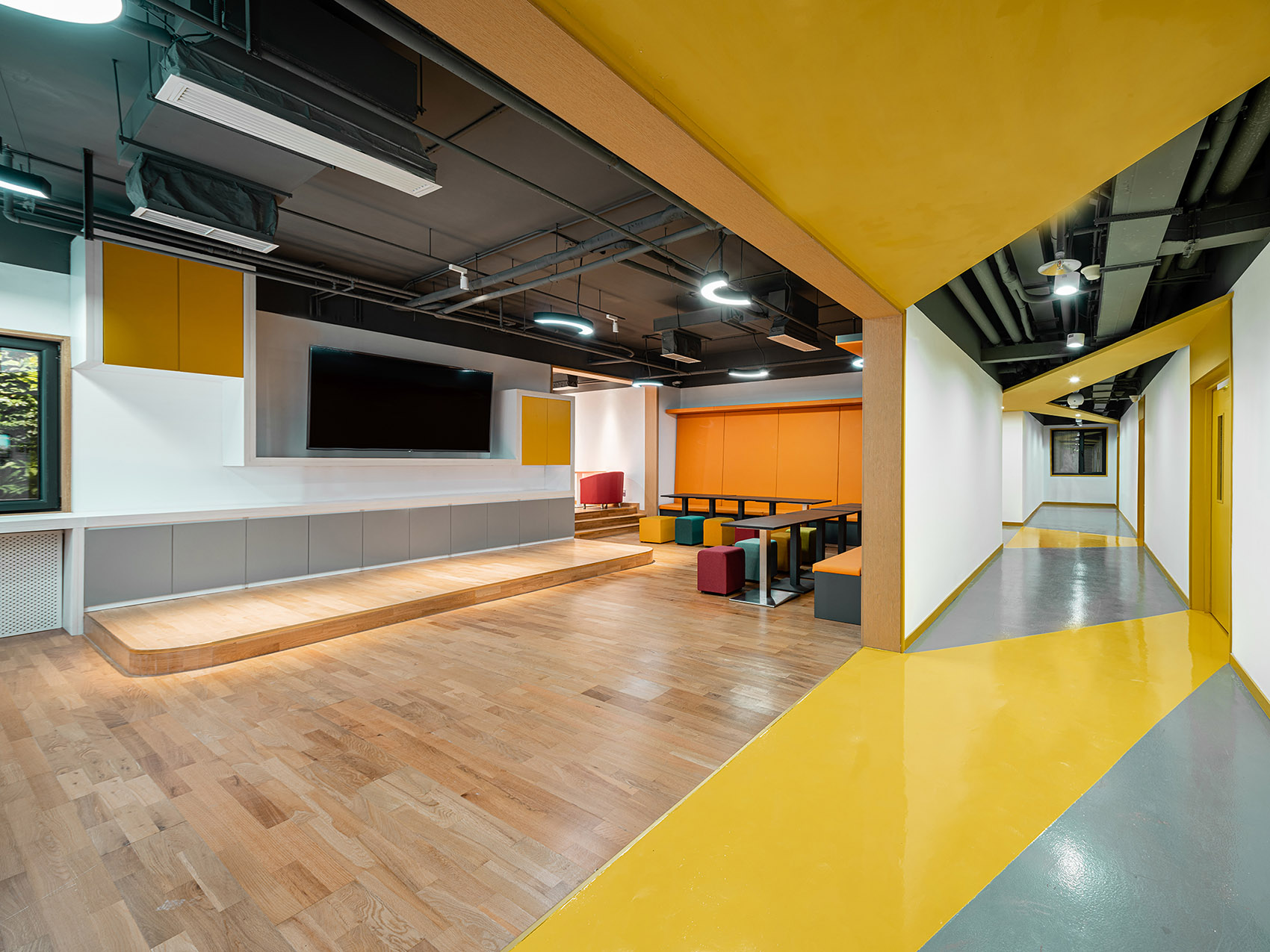
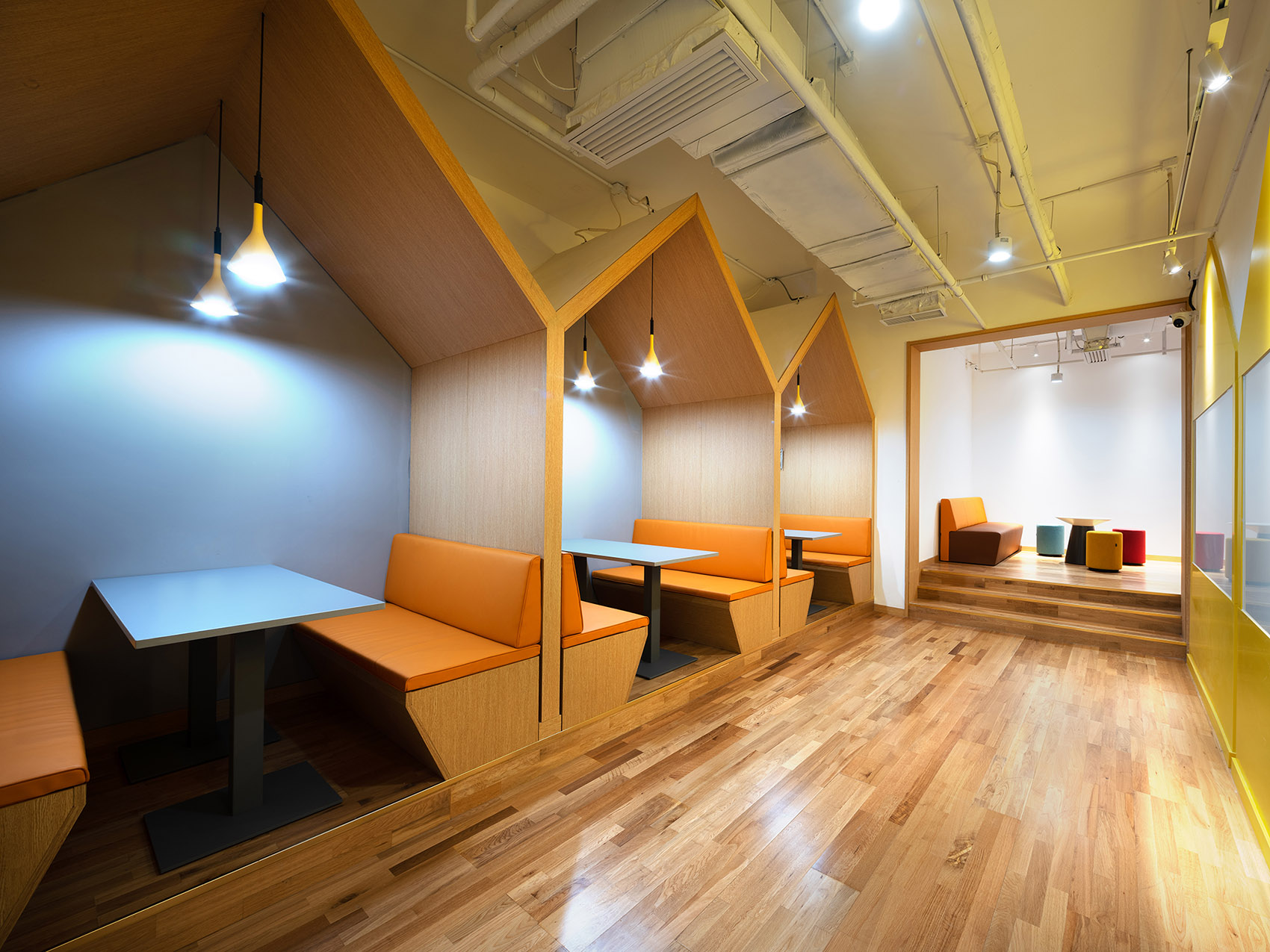
▼ 负一层平面,-1F plan layout ©张玉伟
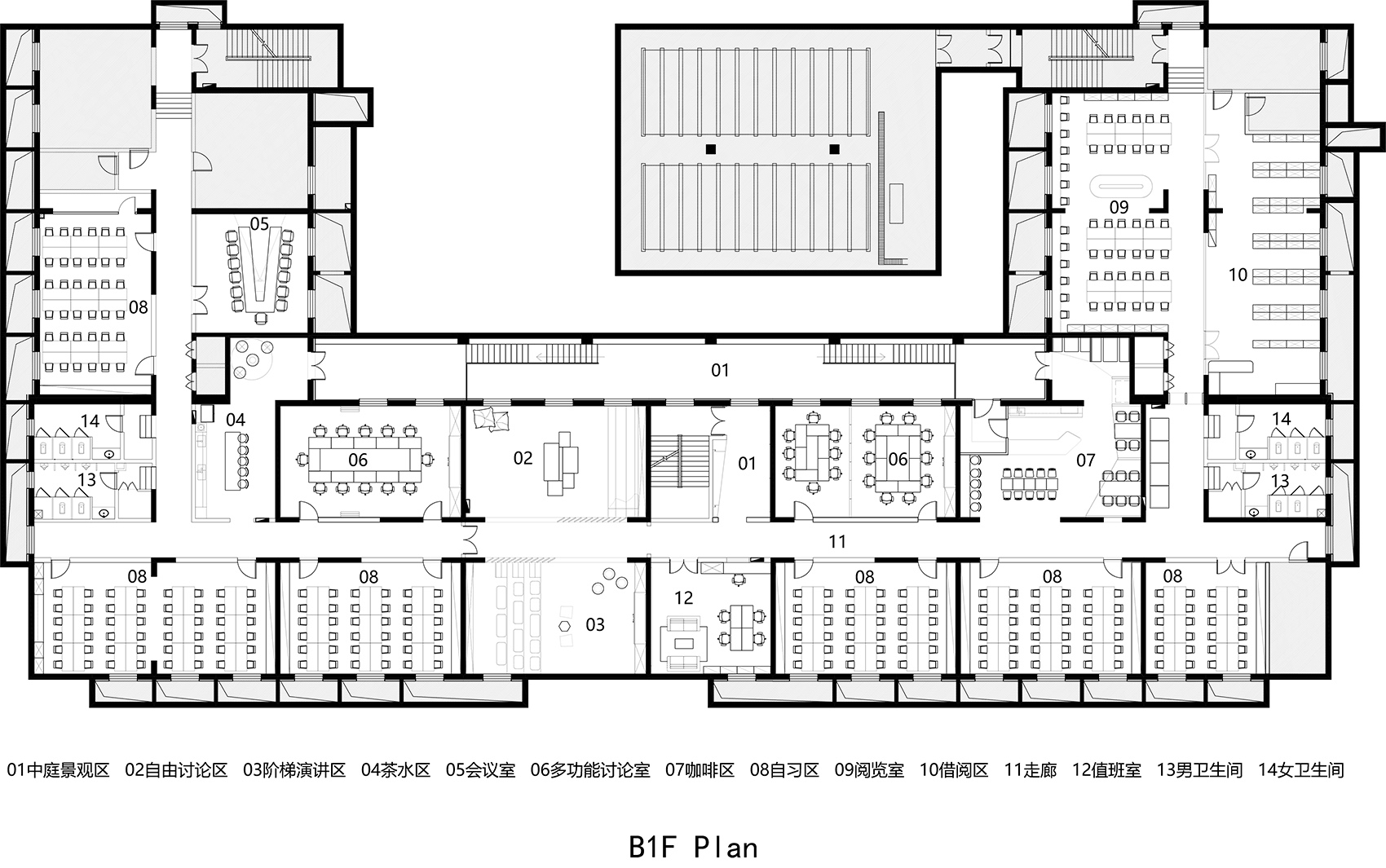
▼ 负二层平面,-2F plan layout ©张玉伟

项目名称:北京大学35号楼宿舍楼室内空间改造设计 项目地点:北京大学 设计机构:狂想建筑设计事务所、北京邸琢空间设计事务所 施工图设计:北京大学建筑设计研究院 面积:3000平方米 设计团队:张玉伟、郑昌辉、许立言、王晓燕 结构:闫志东 机电:杨春龙、郝秀云 绿植景观:王瑜 摄影:周涵滔 英文校对:陆珊珊、彭晓 设计时间:2018年10月 完工时间:2020年4月 主要材料:石膏板、铝板、木材、石材、环氧地坪漆等
